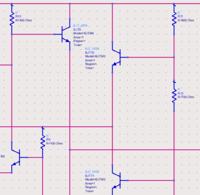analog_curious
Member level 2
hi all
i attach two screenshots of gilbert cell mixer where you can see that that single port is used to supply the differential signal
i also want to confirm my understanding why they have emitter followers at the input to set the DC point for LO stage transistors?
is it because they want to have 50 ohm impedance at the input side?? if not, please help me understand it
also i am not understanding why they need to have 100 ohms for LO+ and 50 ohms for LO-.
thanks all


Dan
i attach two screenshots of gilbert cell mixer where you can see that that single port is used to supply the differential signal
i also want to confirm my understanding why they have emitter followers at the input to set the DC point for LO stage transistors?
is it because they want to have 50 ohm impedance at the input side?? if not, please help me understand it
also i am not understanding why they need to have 100 ohms for LO+ and 50 ohms for LO-.
thanks all


Dan